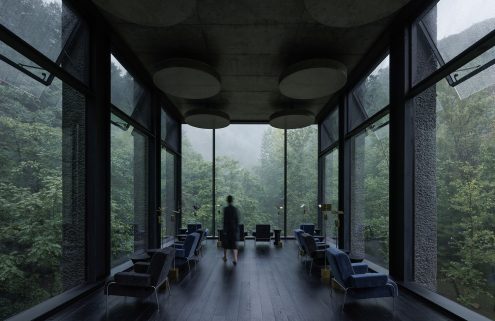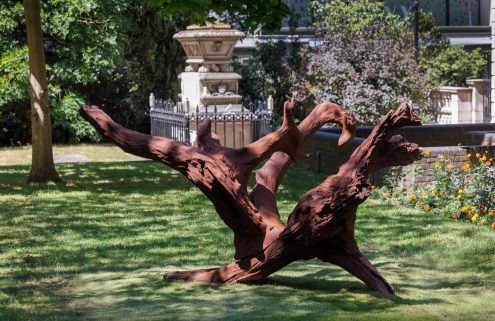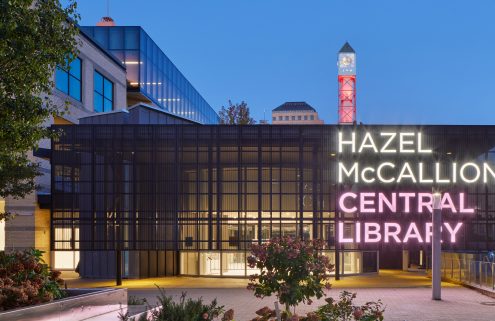
What looks like the hull of a long-lost ship has appeared at Toronto’s Ashbridges Bay – a haunting installation by Nigerian-Canadian artist Oluseye Ogunlesi exploring Canada’s ‘forgotten’ role in the Trans-Atlantic slave trade.
Dubbed Black Ark, the 12-ft-tall immersive sculptural installation is presented as part of the Luminato Toronto Arts Festival. It’s conceived as a ‘symbolic home’ to commemorate the survivors of slavery, with its form evoking both the pitched silhouette of a chapel and the bow of a ship.
Most Canadians are familiar with the Trans-Atlantic slave trade when viewed through the lens of the US and subsequent civil war, and children are taught about the Underground Railroad at school – the secret network which transported enslaved African Americans from the States to ‘freedom’ in Upper Canada.
But the pivotal role Canadian shipyards had, building over 60 ships to transport stolen people from Africa to the American continent, is less well known. Or that ports such as Halifax hosted slavers ships (according to The Coast, the last ship to transport Africans to slavery was actually helmed by a Nova Scotian). Ogunlesi’s architectural instillation illuminates and invites viewers to reflect on this uncomfortable part of Canada’s colonial history.

Black Ark’s charred, weather-proof skin is inspired by the beach houses along the Ivory Coast, which are stained black using diesel sediment. The interior, meanwhile, features an intricate, triangulated skeleton inspired by the wooden ceilings of the Diola people’s homes in Senegal, inset with polished aluminium that distorts the viewer’s reflection.
And while viewers enter the artwork through a 12-ft-high doorway, its cavernous interior becomes smaller and more claustrophobic as you move deeper into the space towards the exit, which at just under 5 ft tall, makes most the viewer duck down as they tumble out into the daylight. It’s a disorientating though intently curated experience elicited by the sculpture.
Oluseye Ogunlesi tells us how a broken mirror led him on a journey of reflection and how he hopes Black Ark will encourage visitors to lean into their discomfort – and celebrate Black culture.

Tell us about the genesis of Black Ark? How did the project evolve into a physical structure?
Oluseye Ogunlesi: I’ve been collecting broken mirrors for three years. I wasn’t entirely sure what I would do with them when I started, but I knew I wanted them to represent the lives of enslaved people sold into the Trans-Atlantic slave trade in exchange for mirrors.
The idea for Black Ark really came from there. I was thinking of a more refined way to communicate that idea that wasn’t just plastering mirrors on a wall. Me and the architect, Toluwalase Rufai, decided to use the mirrors as the inspiration for the structure and recreate that shattered mirror effect and the sense of distortion you get from the mirrors by using polished aluminium [on the Black Ark’s interior].

Describe being inside the Black Ark.
Ogunlesi: We can never emulate the experience of being on a slave ship, but we wanted Black Ark to have a disorientating effect. We achieved that through the mirrors and how sound travels in and echoes inside the structure.
When you walk into the Black Ark through its 12ft high entrance – the ‘freedom’ end – you can see your reflection inside, at the correct scale of 1:1. But as you progress into the structure, your reflection is broken up into many more pieces – it is distorted. That’s how I wanted to capture that stripping of one’s culture and identity, as with enslavement.
The shorter end [of the structure] is just under 5 ft tall. During my research, we found that 4 ft was typically the maximum height enslaved people had in the hold of these ships. As you exit Black Ark through the shorter end, the idea is that you make yourself smaller for a very brief moment. Again, not to emulate. But to evoke a feeling of discomfort that brings to the forefront the reality of what life might have been like on a slave ship.

Dichotomies and juxtapositions are important to your work as a whole. How does this manifest in Black Ark?
Ogunlesi: Mostly through the idea of light versus dark. Despite being outdoors and having this 12ft entrance at one end, it is dark in there, even during the day. And the contrast between the charred exterior and the surrounding trees is really strong.
We were playing with this idea of moving ‘over the plank’ through a door onto the ship – that being the last time a person might have set foot on the Motherland. This idea came to me after visiting the Door of No Return in Gorée Island, Senegal, which is the last door where enslaved people would leave the African shores. With this in mind, we decided to give Black Ark two entry points to symbolise the dual migration of Africans across the Atlantic – as enslaved people (via the smaller entrance) and as free people via the taller entry point.
Black Ark faces east towards Africville in Nova Scotia, but also towards Africa, and you have the view of the water as you move towards the structure.

Photography: Cassandra Popescu

Photography: Cassandra Popescu

Photography: Cassandra Popescu
Why did you burn the exterior of the structure?
Ogunlesi: The decision to burn the structure was inspired by my travels on the Ivory Coast: I noticed homes on the beach stained with diesel sediment, and I was captivated by the beauty of the black against the blue sky and the sand.
It was important to me that Black Ark have a concrete reference to African architecture and design because, alongside the migration of people, there’s been a crucial migration of African culture, food, and aesthetics which continues to shape global culture. I wanted to acknowledge that.
As I was burning the wood to achieve the charred finish, it dawned on me that sometimes to create something beautiful, you must compromise or even destroy it. I began drawing parallels between this burning process and the revolts on some slave ships. In their quest for freedom, enslaved people sometimes killed the captain or burnt down the ships despite not knowing how to sail. Having this thought as I burnt the structure was a very profound moment for me.
Black Ark is at Toronto’s Ashbridges Bay until 5 September 2022. It will then be restaged in a yet-to-be-revealed location in Toronto. Follow Oluseye Ogunlesi on Instagram for more updates on the project.























